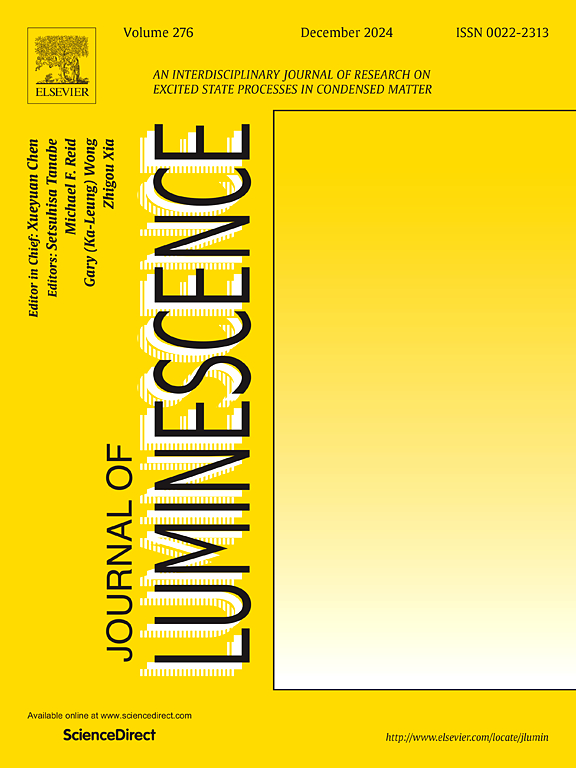Eu2+掺杂Ba2Sc2B4O11荧光粉用于紫外激发白光led
IF 3.3
3区 物理与天体物理
Q2 OPTICS
引用次数: 0
摘要
为了实现健康的照明,可以被紫外光激发的磷转换白光发光二极管(wled)变得越来越重要。在此,我们报道了一种新的黄色发光荧光粉,Ba2-xSc2B4O11:xEu2+ (BSBO:Eu2+),它具有优异的光学性能,适用于紫外线激发的wled。BSBO:Eu2+在230 ~ 450 nm范围内表现出较宽的激发光谱,发射出以577 nm为中心的超宽FWHM约为137 nm的黄光。荧光粉的内部和外部量子效率分别为89%和41%。测定BSBO:0.01Eu2+的荧光寿命为2.74 μs。通过将BSBO:0.01Eu2+与商用蓝色荧光粉(BaMgAl10O17:Eu2+)和365 nm LED相结合,我们获得了相关色温(CCT)为4543 K的暖WLED。通过进一步集成绿色荧光粉((Ba, Sr)2SiO4:Eu2+), WLED获得了卓越的色彩质量,达到了93.0的Ra,而商用YAG:Ce3+的Ra为78.4,CCT为7078 k -非常适合精确的色彩再现需求。本文章由计算机程序翻译,如有差异,请以英文原文为准。
Eu2+ doped Ba2Sc2B4O11 phosphor for UV-violet-excited white LEDs
To achieve healthy illumination, phosphor-converted white light-emitting diodes (WLEDs) that can be excited by ultraviolet (UV)-violet light are becoming increasingly important. Herein, we report a novel yellow-emitting phosphor, Ba2-xSc2B4O11:xEu2+ (BSBO:Eu2+), which exhibits exceptional optical properties and is suitable for UV-violet-excited WLEDs. BSBO:Eu2+ shows a broad excitation spectrum ranging from 230 to 450 nm, and emits a yellow light with an ultrawide FWHM of about 137 nm centered at 577 nm. The internal and external quantum efficiencies of the phosphor were measured to be 89 % and 41 %, respectively. The fluorescence lifetime of BSBO:0.01Eu2+ was determined to be 2.74 μs. By combining BSBO:0.01Eu2+ with a commercial blue phosphor (BaMgAl10O17:Eu2+) and a 365 nm LED, we achieved a warm WLED with a correlated color temperature (CCT) of 4543 K. By further integrating a green phosphor ((Ba, Sr)2SiO4:Eu2+), the WLED achieved superior color quality, reaching an Ra of 93.0, in comparison with the commercial YAG:Ce3+ with an Ra of 78.4, and a CCT of 7078 K—well-suited for precise color reproduction needs.
求助全文
通过发布文献求助,成功后即可免费获取论文全文。
去求助
来源期刊

Journal of Luminescence
物理-光学
CiteScore
6.70
自引率
13.90%
发文量
850
审稿时长
3.8 months
期刊介绍:
The purpose of the Journal of Luminescence is to provide a means of communication between scientists in different disciplines who share a common interest in the electronic excited states of molecular, ionic and covalent systems, whether crystalline, amorphous, or liquid.
We invite original papers and reviews on such subjects as: exciton and polariton dynamics, dynamics of localized excited states, energy and charge transport in ordered and disordered systems, radiative and non-radiative recombination, relaxation processes, vibronic interactions in electronic excited states, photochemistry in condensed systems, excited state resonance, double resonance, spin dynamics, selective excitation spectroscopy, hole burning, coherent processes in excited states, (e.g. coherent optical transients, photon echoes, transient gratings), multiphoton processes, optical bistability, photochromism, and new techniques for the study of excited states. This list is not intended to be exhaustive. Papers in the traditional areas of optical spectroscopy (absorption, MCD, luminescence, Raman scattering) are welcome. Papers on applications (phosphors, scintillators, electro- and cathodo-luminescence, radiography, bioimaging, solar energy, energy conversion, etc.) are also welcome if they present results of scientific, rather than only technological interest. However, papers containing purely theoretical results, not related to phenomena in the excited states, as well as papers using luminescence spectroscopy to perform routine analytical chemistry or biochemistry procedures, are outside the scope of the journal. Some exceptions will be possible at the discretion of the editors.
 求助内容:
求助内容: 应助结果提醒方式:
应助结果提醒方式:


